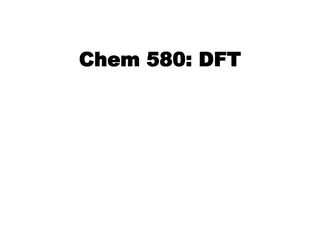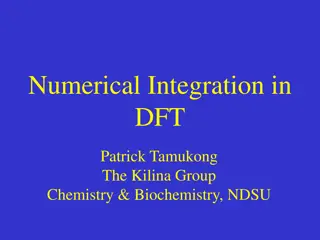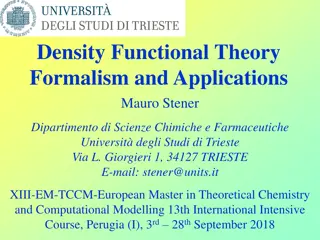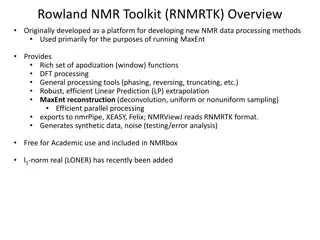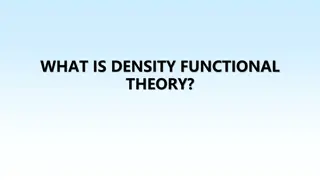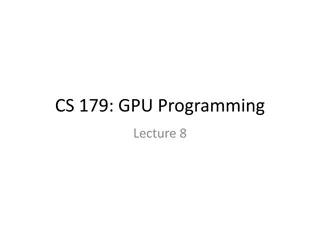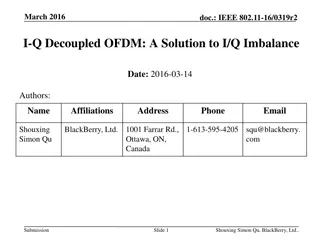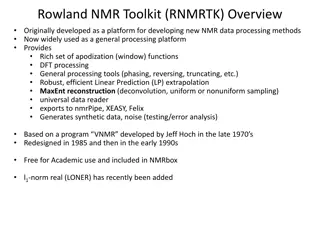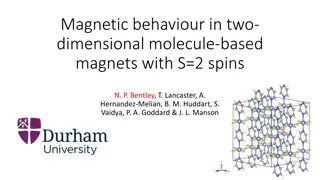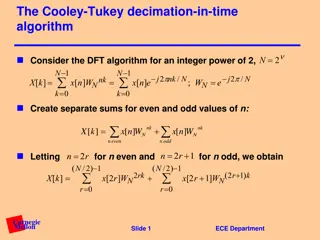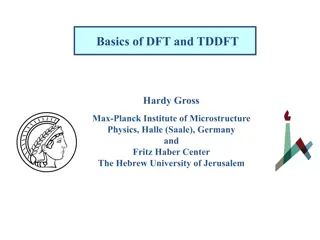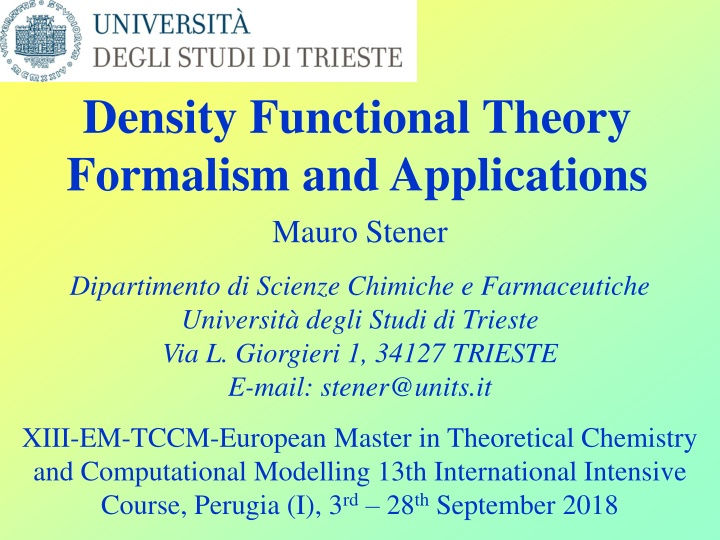
Density Functional Theory Formalism and Applications Overview
Learn about Density Functional Theory (DFT) formalism, equations, computational implementations, and applications such as plasmons and core electron excitations. Understand electron density and N-electron wavefunctions in the context of DFT theory.
Download Presentation

Please find below an Image/Link to download the presentation.
The content on the website is provided AS IS for your information and personal use only. It may not be sold, licensed, or shared on other websites without obtaining consent from the author. If you encounter any issues during the download, it is possible that the publisher has removed the file from their server.
You are allowed to download the files provided on this website for personal or commercial use, subject to the condition that they are used lawfully. All files are the property of their respective owners.
The content on the website is provided AS IS for your information and personal use only. It may not be sold, licensed, or shared on other websites without obtaining consent from the author.
E N D
Presentation Transcript
Density Functional Theory Formalism and Applications Mauro Stener Dipartimento di Scienze Chimiche e Farmaceutiche Universit degli Studi di Trieste Via L. Giorgieri 1, 34127 TRIESTE E-mail: stener@units.it XIII-EM-TCCM-European Master in Theoretical Chemistry and Computational Modelling 13th International Intensive Course, Perugia (I), 3rd 28thSeptember 2018
Summary 1. THEORY - DFT Review of DFT basic theory and equations 2. THEORY - TDDFT with the aim to underline what is general from Linear Response formalism. 3. COMPUTATIONAL - Some numerical aspects of the implementation in the ADF code, most important computational choices, how to assign spectral features. New TDDFT algorithm. 4. APPLICATIONS: 4.a. Plasmons in metal clusters. 4.b. Core electron excitations (NEXAFS).
Electron Density Take a system with only 1 electron, the electron density at point r0is: ( ) ( ) 0 0 r r = 2 This can be interpreted as the action of a density operator: ( ) ( 0 r r = ) r 0 ( ) 0 r Extension to N-electrons: ( ) ( ) ( r ) ( ) = i 1 ( ) ( ) 0 r ( ) 0 r = 2 = = * * r r r r r d 0 0 N ( ) = r r r 0 0 i
Electron Density Now consider in general a N-electron antisymmetric wavefunction, X1=x1,y1,z1, 1: hidden spin coordinate ( ) ( ) ( = 1 i ( ) ( ) ( ,... , 0 1 2 1 r r X X ( ) ( ) ( ,... , 0 2 2 1 r r X X ( ) ( N ) ( ) = * r X X r r X X X X , ,... , ,... , ,... d d 0 1 2 0 1 2 1 2 i ) = + + * X X X X , ,... ) , ,... d d 1 2 1 2 + * X X X X , ,... , ,... ... d d 1 2 1 2 ) ( ) = * X X r r X X X X , ,... , ,... , ,... N d d 1 2 1 0 1 2 1 2
Electron Density Now consider in general a N-electron antisymmetric wavefunction, X1=x1,y1,z1, 1: hidden spin coordinate ( ) = = 1 i ( ) ( ) ( N ( ) ( r i ) = * X X X X X X , ,... , ,... , ,... V V d d 1 2 1 2 1 2 ) ( ) ( ) 1 r V = = * X X r X X X X r r , ,... , ,... , ,... N V d d d 1 2 1 1 2 1 2 1 1
Density Functional Theory (DFT) P. Hohenberg and W. Kohn, Phys. Rev. 136 (1964) B864 Nobel Prize for chemistry 1998 Description of the electronic structure of the Ground State In Ab-initio - the N-electron system is described by the wave- function: ( X X X , , , 2 1 ) ( ) = , X , , x y z N i i i i i Cartesian coord. Spin Coord. In DFT - the N-electron system is described by the Electron Density : ( ) r r ( ) z = x , , y
Functional: a function application: : F f More recent formalization: M. Levy, Proc. Natl. Acad. Sci. (USA) 76 (1979) 6062. N-electrons, non-relativistic, Born Oppenheimer approximation (atomic units): j i j i i 1 2 r r 1 1 N N N general, in practice electron-nucleus interaction ( ) ( ) r = = i H = + + 2 V i EXT i 1 Nucl Z = r K R V EXT i r K i K H = + + T V V ee EXT
Definition of the functional F[] = + min F T V ee : N-electron antisymmetric wave-function ( ) r = + r r [ ] ( ) E F V d EXT
Variational theorem: GS E ) 2 ) 1 E E = GS E GS Demonstration 1) = + = + min F T V T V min min ee ee ( ) r = + + = r r ( ) E T V V d min min ee EXT H = + + = T V V E min min min min ee EXT GS
Demonstration 2) = + + = E T V V GS GS + ee EXT GS ( ) r = + r r ( ) T V V d E GS ee GS EXT GS GS But from 1) also: GS E = E E E E E GS GS GS GS GS The idea is to minimize E[ ] with respect to , this furnishes the GS density and energy. Formal, not practical.
Minimization of E[] min + = = + F T V T V Recall that: min min ee ee This allows to define energy functionals: = = T T V V min min min min ee ee Eventually, the next expression must be minimized: ( ) r = + + r r ( ) E T V V d ee EXT Direct approach: Thomas-Fermi, functionals are approximated (electron gas) and the density is varied in order to reach the minimum of E[ ].
Kohn-Sham approach Fictius system of non-interacting electrons (Vee=0), but with the same density as the real systems of interacting electrons. This term must be chosen in order to have the same density as the real system 1 = 1 N N ( ) r = i = i H = + 2 V KS i KS i 2 1 1 1 1 + = 2 det ... V 2 KS N KS i i i 2 ! N 1 N N ( ) r ( ) ( ) r = i = = 2 * r T 0 i i i i 2 = 1 1 i Spin-orbitals Spatial-orbitals
Kohn-Sham approach Interacting system: T E + = J T E 0 + = J[ ] is the classical electrostatic interaction: E ( ) r V EXT + XC r r r r ( ( ( ) ) V V + d ee + EXT r ) d r r 1 ( ) ( ) = r r J d d r r 2 Finally, EXC[ ] is defined as follows: = + E T T V J 0 XC ee EXC[ ] not known, but small wrt other terms, approximated by models (electron gas)
Kohn-Sham approach J T E 0 + = ( ) r + + r r Minimize: ( ) E V d XC EXT With the constrain: = r d ) ( r N ( ) 0 = r d r ( ) E Functional derivative T0 ( ) r r r E ( ) = r For the interacting system: + + + r XC d V EXT Equal: we impose the same solution ( )! T0 ( ) = r + V For the non-interacting system: KS
Kohn-Sham equations ( ) r 1 r E ( ) r + = 2 V = + + r XC V d V KS i i i KS EXT 2 r E = XC V = h XC KS equations KS i i i N ( ) r ( ) ( ) r = i = * r i i 1 hKSdepends from the density ( ) so a Self Consistent Field (SCF) procedure must be employed to solve the KS equations, like in Hartree Fock
Functional derivative f G : ( ) r d = + G Linear in G G G Differential: = .. . + r G Extension of the concept of exact differential: ( ) x x f ,..., , 2 1 N f : N f = i G = N x df dx i x 1 i ( ) r r d ( ) = dG = 1 , ,... G G 2
Functional derivative:examples r 2 r r 2 = r r 2 2 r r 1 ( ) ( ) = r r J d d r 1 r r r r 1 ( ) ( ) ( ) ( ) = + = r r r r J d d d d r r r 2 r r r 1 ( ) ( ) 1 ( ) ( ) + = r r r r d d d d r r r r r r ( ) ( ) ( ) d = = r r r r ( ) d d d r r r r r d ) ( r J = r r
Functional derivative:examples Local Density Approximation (LDA): ( ) r = LDA XC LDA XC r r ( ) E d ( ( ) r ) d ( ) r ( ) r = LDA XC + = LDA XC LDA XC LDA XC r r r ( ) ( ) E ( ) r = + = LDA XC r r r r ( ) ( ) ( ) d ( ) r LDA XC ( ) r = + LDA XC r r r ( ) ( ) d ( ) r LDA XC E ( ) r = = + LDA XC r ( ) XC V XC
Local Density Approx. (LDA) E XC = ( ) r X XC = Models can be used to approximate Xand C: in LDA the Uniform Electron Gas is employed. ( ) r X ( ) r LDA LDA XC ( ) r r r ( ) d ( ) r + LDA C LDA LDA 1 1 3 3 ( ) r 3 3 1 3 1 = LDA X v 3 In LDA Xis analytic: Slater (1951) suggested the X method, an approximation of HF with local exchange: = LDA 3 4 1 3 3 3 ( ) r 1 = X v 3 2 In LDA the Cterm can be obtained from Statistical Mechanics calculations (Quantum Monte Carlo), such calculations furnish Cwhich can be fitted with very complicated analytical expressions:
DFT: the Kohn-Sham (KS) method The electron density can be extracted from the KS reference system solving the KS equations: = = ,..., 1 H i n KS i i i ( ) r 1 Z r r d ( ) r = + + 2 N H V KS XC 2 r r R N N occ i * = in i i SCF iterative solution
Kohn-Sham (KS) results: 1. imolecular orbitals and their energies iare obtained. 2. The potential is local (at variance with HF) 3. VXCmust be approximated in practice (LDA, GGA, ) XC V = E XC 4. Total energy E[ ] and one-electron local operator properties (gradients for example) of the systems can be calculated from density
EXC functional choice Functional accuracy can be improved: 1. LDA (good geometries, bad energies) 2. GGA: also is considered (improved energies) 3. Hybrids: non-local Fock exchange (best compromise B3LYP) 4. Asymptotic corrections (LB94, )(R. van Leeuwen and E. J. Baerends, PRA 49 (1994) 2421) occupied 1 ( ) r ( ) r i 2 = 5. Meta GGA: dependence KE density: i 2 Common VXCchoices do not obey to correct asymptotic 1/r behavior (long-range exchange), this feature is important to obtain accurate excitation energies and intensities in TDDFT
Kieron Burke, Perspective on density functional theory JCP 136 (2012) 150901
DFT: numerical considerations Molecules: LCAO formulation. The KS eigenfunctions are the molecular orbitals: linear combination of basis functions = k 1 The problem to obtain KS eigenvalues and eigenfunctions, in LCAO is reduced to a Generalized Diagonalization: C HKS = Input: H H = Basis ( ) r ( ) r = C i k ki SCE Output: C E = KS i KS j ij ij = ij S ij i ij i j
DFT: numerical considerations Two different philosophies to build the HKS matrix: 1) Numerical integration (ADF code), STO basis set 2) Analytical integration (Gaussian ) GTO basis set ADF: computational scheme - Density fitting ( ) ( ) ( ) = = = = i j k i 1 1 1 1 am are obtained imposing: With the constrain: d = fit N N basis basis ( ) ( ) r ( ) r ( ) r ( ) ~ m = = * * * = r r r r f r C C a i i ji ki j k m m ( ( ) r ( ) r ) r d ~ 2 min N ( ) r ~ r
ADF: computational scheme - Density fitting allows computational economy in the calculation of the coulomb matrix elements: ( ) r r r r d = VH NP = ( ) ( ) ( ) H k r V r = V r w i H j i k j k k 1 k ( ) r ( ) r ( ) r ~ fit fit f r d r r d r r d ( ) k r ( ) k r = = = m r V a a F H m m m r r r m m k k k
Comments: 1. DFT: the variational theorem is formal, not directly used! 2. KS: a fictious non-interacting system is introduced to calculate the GS density, this allows to work out the Kohn- Sham equations, which are implemented in computer DFT codes, useful in practice! 3. EXC: unknown term, must be approximated by suitable models. 4. Implementation: standard LCAO formalism, molecular orbitals and basis set.




